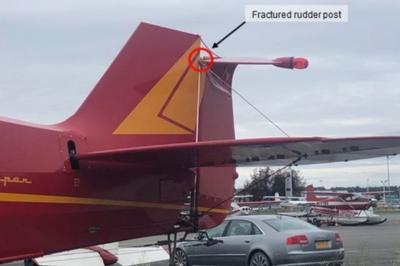Sat, Jan 29, 2022
Piper Cruisers May Require Replacement for Aging Rudder Posts
The results of an investigation into a number of incidents involving vintage Piper aircraft have been released, exposing a vulnerability in aircraft that have remained in service to the point that lifetime fatigue could take its toll to the point of breakage. Notable pictures of example aircraft show the upper portion of the rudder bent beyond 90°. The part in question can be found in Piper PA-12, PA-14, and PA-18s still in service.

A series of incidents with similar patterns of parts failure have been investigated by the NTSB, bringing about concerns over the steel selection used in Piper rudder posts built prior to 1974. The part number in question, 40622, is made of AISI 1025 carbon steel, which the NTSB says are "susceptible to fatigue cracking under normal service conditions." When originally certified in the 1940s, 40622 complied with the static load conditions required, but in service, the parts were subjected to dynamic alternating and fatigue loads throughout their lifetime. The NTSB found through structural analysis that "bending stresses on the rudder post from certification gust and maneuver loads are significantly closer to the endurance limit for rudder posts made of AISI 1025 carbon steel than they are for those made of AISI 4130 low-alloy steel." Investigation did identify corrosion, scratches, and surface wear on the examined parts, which further increased chances of failure due to stress-concentrating surface
features not available when new.
While the tested rudder posts all had beacons or strobes installed that increased susceptibility to failure, the board notes that even without the extra equipment, the in-service stresses probably exceed endurance limits for the original rudder post material. Aging, vintage aircraft could have more modern substitutions in service, if the rudder posts were replaced in line with AC-23-27. For now, the NTSB recommends operators watch out for the issue, and the FAA issues an airworthiness directive.

"Therefore, the NTSB recommends that the FAA issue an airworthiness directive that describes the safety risk associated with the continued use of Piper part number 40622 rudders equipped with a post made of AISI 1025 carbon steel and that requires owners and operators to address the unsafe condition, such as by replacing them with rudders equipped with a post made of AISI 4130 low-alloy steel or its equivalent."
More News
He Attempted To Restart The Engine Three Times. On The Third Restart Attempt, He Noticed That Flames Were Coming Out From The Right Wing Near The Fuel Cap Analysis: The pilot repor>[...]
Make Sure You NEVER Miss A New Story From Aero-News Network Do you ever feel like you never see posts from a certain person or page on Facebook or Instagram? Here’s how you c>[...]
From 2009 (YouTube Edition): Leading Air Show Performers Give Their Best Advice for Newcomers On December 6th through December 9th, the Paris Las Vegas Hotel hosted over 1,500 air >[...]
Aero Linx: NASA ASRS ASRS captures confidential reports, analyzes the resulting aviation safety data, and disseminates vital information to the aviation community. The ASRS is an i>[...]
“For our inaugural Pylon Racing Seminar in Roswell, we were thrilled to certify 60 pilots across our six closed-course pylon race classes. Not only did this year’s PRS >[...]
 NTSB Final Report: Rutan Long-EZ
NTSB Final Report: Rutan Long-EZ ANN FAQ: Turn On Post Notifications
ANN FAQ: Turn On Post Notifications Classic Aero-TV: ICAS Perspectives - Advice for New Air Show Performers
Classic Aero-TV: ICAS Perspectives - Advice for New Air Show Performers ANN's Daily Aero-Linx (06.28.25)
ANN's Daily Aero-Linx (06.28.25) Aero-News: Quote of the Day (06.28.25)
Aero-News: Quote of the Day (06.28.25)




